The numerical barbecue season is now open!
![[Translate to English:] Merkle CAE Solutions Bild Grillen CFD Simulation Teaser [Translate to English:] Merkle CAE Solutions Bild Grillen CFD Simulation Teaser](/fileadmin/_processed_/e/4/csm_Merkle-cae-solutions-numerische-grillsaison_eb06f85346.jpg)
Now it's time again, when the weather suits, to fire up the grill. Unfortunately, I do not always get the steaks on the home gas grill quite perfect with regard to the wishes of my guests.
Although this would be possible with a meat thermometer, it fails in practice at the latest when only one thermometer is available for several guests.
Besides, the professional griller intuitively knows when the meat is ready, doesn't he?
The theory
Let's dive into the lowlands of theory with the help of chatGPT.
Our little, know-it-all, electronic smarty pants gives out the following information:
"Core temperatures of beef steaks vary depending on the thickness of the meat and the desired cooking level. Here are the typical core temperatures for the three most common cooking stages:
- Well Done: 70-75°C
- Medium: 60-65°C
- Rare/Medium-Rare: 50-55°C
It is important to use a meat thermometer to accurately measure the core temperature to achieve a perfect cooking level. After grilling, let the steak rest for a few minutes to relax the meat and distribute the juices before cutting." (Didn't even ask, but he/she/it spit it out to me as a goodie).
So even chatGPT can only grill with a thermometer. I would much rather know how long the meat will be on the grill and when I ideally need to turn it. I always have my watch and cell phone handy, but a meat thermometer in my pocket runs the risk of entering the wrong tissue.
My gas grill also tells me what temperature it's at, and I can also set it pretty consistently. So that helps.
The analytical solution
Let's try the analytical method first.
Transient thermal problems lead to an ugly partial differential equation of the type,
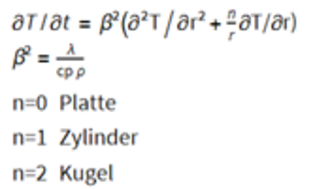
which can be solved only for one-dimensional, symmetric special cases and for three defined boundary conditions, and then leads to solutions in the form of infinite series. Not that I don't know how to do it. If you don't believe it, I'll gladly send you the complete solution in the form of a Mathematica sheet. Unfortunately, this is even more inconvenient than a meat thermometer in your pocket.
The practical solution
You guessed it long ago; a viable solution to our problem is a 3D calculation using a transient 3D CFD flow simulation. How fortunate that we at Merkle CAE Solutions have already calculated a gas grill for the Kussmaul company, on which we can test the whole thing right away. All that's missing are the steaks.
The geometry of beef steaks can also be found on the Internet, add it on and our geometry model is ready (see Fig. 1).
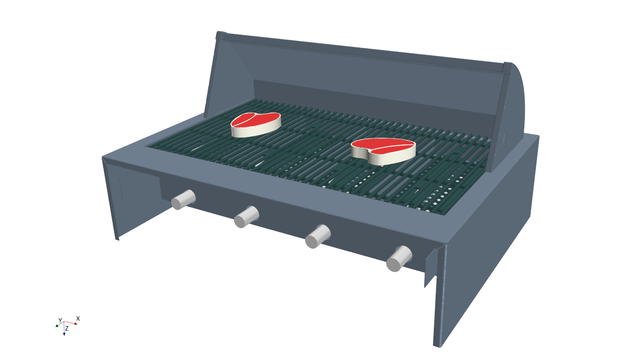
The material data
A small obstacle still arises: Where are there suitable material data that we can use for our steak model?
Since some people behave like cattle, it is obvious that the values here are not too far apart. Fortunately, there is a PhD thesis on this on the web that gives us everything we need as input to our CFD simulation model. Beef, human flesh, it fits. In times of need, the devil eats flies.
The data used in the summary:
I have attached the link to the dissertation for you. It is very interesting. By appropriate experiments one can probably determine in forensics how long someone has been dead.
The boundary conditions
We set the average temperature at the grill level to 300°C; the rest, in particular the temperature of the gas flame, results from the flow field. Since the grill is mostly closed during grilling, the lid also remains closed in our simulation.
But how can the two steaks be turned numerically? Here is an ingenious trick that I am a bit proud of: By mirroring the temperature distribution during turning.
We therefore do not turn the steak, but only the temperature field. Numerically, we do not need to open the lid of the grill for this either, since the turning time during physical grilling is negligible compared to the total cooking time.
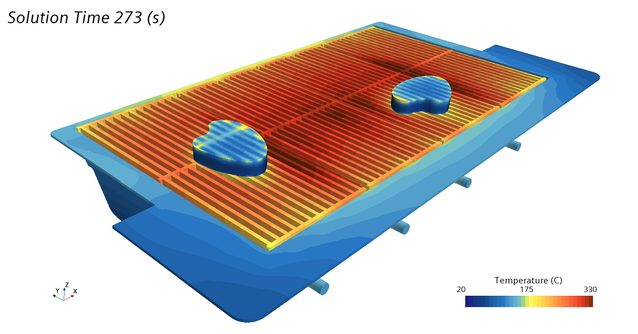
The simulation
A moving and animated summary of the results from the CFD simulation can be found in the video below. Please be sure to listen to the acoustic background when turning the steaks, I've already managed to do that!
The result
In order to be able to assess the result of our numerical grilling, we now look at the temperature distribution in the average of the two stakes at the last time step after a total of 600 seconds (see Fig. 3). The minimum core temperature here is approx. 60°C.
If the steaks are left to rest for a while, as recommended, the temperature will equalize with the mean value. This is then roughly estimated at 70°C.
This corresponds to a Well Done. So that would not be for my delicate taste buds. I prefer Medium Rare.
So, a grilling time of 600 seconds = 10 minutes (about 5 minutes on one side) is definitely too long. Probably a little more than half the time will do for my taste.
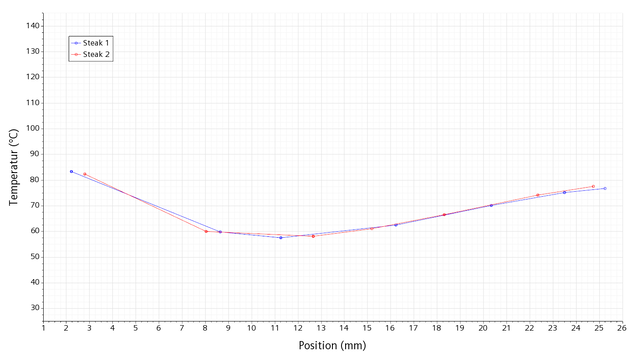
Back to the analytical model
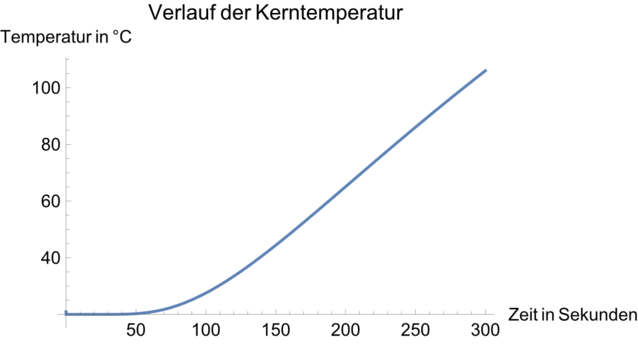
The comparison with an analytical solution is also interesting. The only problem here is that the temperature distribution must be symmetrical, i.e. it is grilled from both sides at the same time. Otherwise, there is no known solution for this.
With simultaneous grilling on both sides, the real total time is reduced to slightly more than half.
The diagram below shows the analytical course of the core temperature for this scenario with a uniformly specified surface temperature of 300°C on both sides of the steak.
In the contact area of the steak on the grating, the specified temperature is probably the correct boundary condition, but between the grating bars, the heat transfer does not take place by conduction, but by convection. Therefore, the analytically determined temperature profile might additionally result in somewhat too high temperatures compared to reality or the CFD model.
Back to my ideal steak: Medium rare would be achieved after 2.5 - 3 minutes grilling on one side and 2.5 - 3 minutes grilling on the other side. This also coincides well with my practical experience
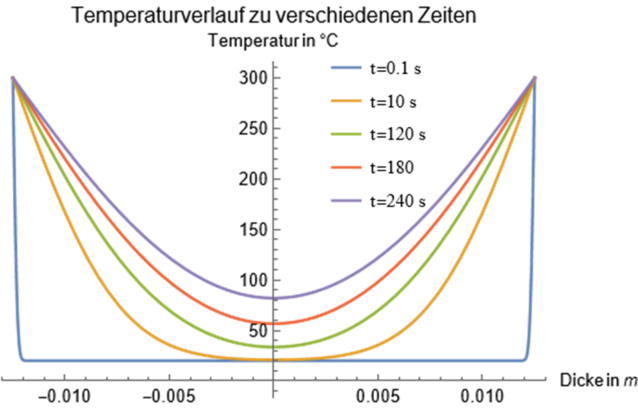
Ich hoffe, Sie hatten Spaß beim Lesen und ich wünsche Ihnen für die kommende Grillsaison nicht nur perfekte Steaks und eine gechillte Zeit, sondern auch ein besseres Verständnis, was thermisch und physikalisch beim Grillen eines Steaks passiert.
Yours Stefan Merkle

PS: Attached is the link to the material data:
https://www.db-thueringen.de/servlets/MCRFileNodeServlet/dbt_derivate_00050563/DissSchenkl.pdf
For the Mathematica Sheet with the analytical solution please send me a short mail with the subject: Crickets, analytical solution.
PPS: Thanks to Carsten and Chadi for the 3D calculations.